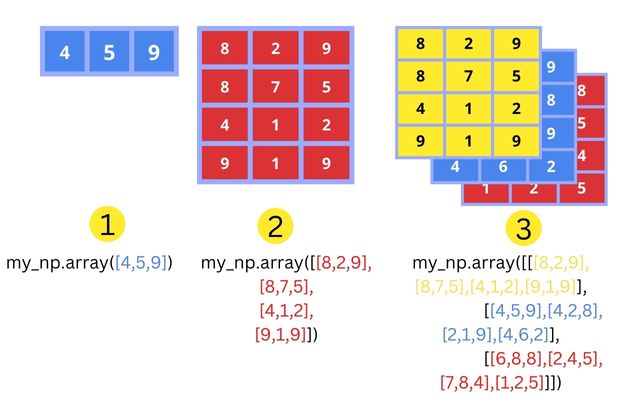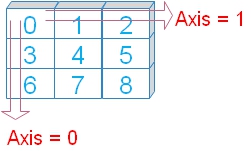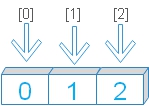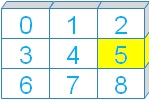NumPy ndarray — Understanding Dimensions, Shape & Attributes
In NumPy, every array you create is an ndarray — the core data structure that stores elements of the same type in a continuous block of memory. It enables fast mathematical and logical operations across dimensions. Understanding properties like ndim, shape, dtype, and strides is essential for mastering how NumPy manages multidimensional data efficiently.

 We can create powerful multidimensional arrays in numpy. We can arrage the elements in number of rows and columns.
We can create powerful multidimensional arrays in numpy. We can arrage the elements in number of rows and columns.
Let us try some attributes to know details of the array. These attributes we will apply to different types of arrays ( dimension ).
base | Base object, if memory is from other object |
dtype | type of data. Integer, float, Python object, etc |
data | buffer object showing start of the data |
flags | Details about Memory Layout |
itemsize | Size in bytes |
ndim | Number of dimensions or axis |
nbytes | Total bytes used by all the elements |
shape | rows and columns ,tuple , length indicates numbrer of axes, product of elements is same as size |
size | Total number of elements |
strides | Returns a tuple with bytes consumed by each dimension |
Single dimensional array

import numpy as my_np
my_array = my_np.array([0,1,2])
print(my_array)[0 1 2]import numpy as my_np
my_array = my_np.array([ 0, 1, 2])
print(my_array.base) # None
print(my_array.dtype) # int32
print(my_array.data) # <memory at 0x0000021772F6F108>
print(my_array.flags) # C_CONTIGUOUS : True
# F_CONTIGUOUS : False
# OWNDATA : True
# WRITEABLE : True
# ALIGNED : True
# WRITEBACKIFCOPY : False
# UPDATEIFCOPY : False
print(my_array.itemsize) # 4
print(my_array.ndim) # 1
print(my_array.nbytes) # 12
print(my_array.shape) # (3,)
print(my_array.size) # 3
print(my_array.strides) # (4,) Two dimensional array

import numpy as my_np
my_array = my_np.array([[0, 1, 2],[3, 4, 5],[6, 7, 8]])
print(my_array[1][2]) # output is 5import numpy as my_np
my_array = my_np.array([[0, 1, 2],[3, 4, 5],[6, 7, 8]])
print(my_array.base) # None
print(my_array.dtype) # int32
print(my_array.data) # <memory at 0x0000021772EC28B8>
print(my_array.flags) # C_CONTIGUOUS : True
# F_CONTIGUOUS : True
# OWNDATA : True
# WRITEABLE : True
# ALIGNED : True
# WRITEBACKIFCOPY : False
# UPDATEIFCOPY : False
print(my_array.itemsize) # 4
print(my_array.ndim) # 2
print(my_array.nbytes) # 36
print(my_array.shape) # (3,3)
print(my_array.size) # 9
print(my_array.strides) # (12,4) Three Dimensional array

import numpy as my_np
#x=complex(98,97)
my_array = my_np.array([[[ 0, 1, 2],[ 3, 4, 5],[ 6, 7, 8]],
[[ 9, 10, 11],[12, 13, 14],[15, 16, 17]],
[[18, 19, 20],[21, 22, 23],[24, 25, 26]]])
print(my_array[2][2][1]) # 25import numpy as my_np
my_array = my_np.array([[[ 0, 1, 2],[ 3, 4, 5],[ 6, 7, 8]],
[[ 9, 10, 11],[12, 13, 14],[15, 16, 17]],
[[18, 19, 20],[21, 22, 23],[24, 25, 26]]])
print(my_array.base) # None
print(my_array.dtype) # int32
print(my_array.data) # <memory at 0x00000217728F4E58>
print(my_array.flags) # C_CONTIGUOUS : True
# F_CONTIGUOUS : False
# OWNDATA : True
# WRITEABLE : True
# ALIGNED : True
# WRITEBACKIFCOPY : False
# UPDATEIFCOPY : False
print(my_array.itemsize) # 4
print(my_array.ndim) # 3
print(my_array.nbytes) # 108
print(my_array.shape) # (3,3,3)
print(my_array.size) # 27
print(my_array.strides) # (36,12,4) Adding dimension while creating array
import numpy as np
npr = np.array([ 0, 1, 2],ndmin=3) # adding dimension to array
print(npr) # [[[0 1 2]]] # print array
print(npr.ndim) # 3 ( display dimension of the array ) 
Subhendu Mohapatra
Author
🎥 Join me live on YouTubePassionate about coding and teaching, I publish practical tutorials on PHP, Python, JavaScript, SQL, and web development. My goal is to make learning simple, engaging, and project‑oriented with real examples and source code.
Subscribe to our YouTube Channel here
This article is written by plus2net.com team.
https://www.plus2net.com

26-02-2024 | |
| Very well written, visuals have really helped. Great job, thanks! | |
 Python Video Tutorials
Python Video Tutorials